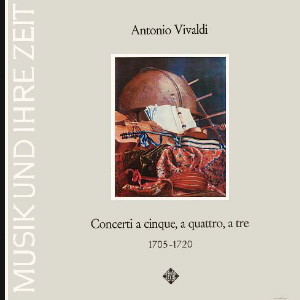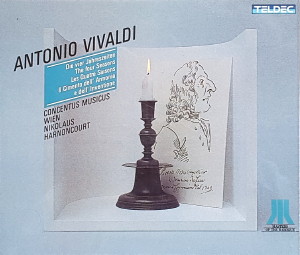 |
1 LP -
SAWT 9528-A - (p) 1968
|
 |
| 3 CD -
8.35777 XD - (c) 1989 |
|
| Antonio Vivaldi
(1678-1741) |
|
|
|
|
|
|
|
| Concerti a cinque, a quattro,
a tre - um 1705-1720 |
|
|
|
|
|
|
|
Concerto D-dur für
Blockflöte, Oboe, Violine, Fagott und
Basso continuo (F. XII/25)
|
|
10' 24" |
A1 |
- Allegro
|
4' 06" |
|
|
| - Largo |
2' 30" |
|
|
| - Allegro |
3' 52" |
|
|
| Concerto D-dur für
Blockflöte, Violine und Violoncello (F.
XII/7) |
|
9' 33" |
A2 |
| - Allegro |
3' 57" |
|
|
- (?)
|
2' 23" |
|
|
- Allegro
|
3' 13" |
|
|
| Concerto g-moll für Blockflöte,
Oboe, Violine, Fagott und Basso continuo
(F. XII/20) |
|
8' 39" |
B1 |
| - Allegro |
3' 18"
|
|
|
| - Largo |
2' 03" |
|
|
| - Allegro |
3' 18" |
|
|
| Concerto C-dur für Blockflöte,
Oboe, 2 Violinen und Basso continuo (F.
XII/30) |
|
7' 24" |
B2 |
- Adagio. Allegro
|
2' 55"
|
|
|
| - Largo |
2' 28" |
|
|
- Allegro assai
|
2' 01" |
|
|
| Concerto a-moll für Blockflöte,
2 Violinen und Basso continuo (F.
XII/11) |
|
6' 47" |
B3 |
| - Allegro |
2' 51" |
|
|
| - Largo |
1' 28" |
|
|
| - Allegro |
2' 28" |
|
|
|
|
|
|
Frans Brüggen,
Blockflöte in f' (Alt-Blockflöte
in f', Kopie nach Martin
Skowronek, Bremen 1966, nach einer
Alt-Blpckflote von J.P. Bessan)
|
|
Jürg
Schaeftlein, Barockoboe
(P. Paulhahn, deutsch, um 1720)
|
|
Otto
Fleischmann, Barockfagott
(Wien 18. Jh.)
|
|
Alice
Harnoncourt, Barockvioline
(Jacobus Stainer, Absam 1658)
|
|
| Walter
Pfeiffer, Barockvioline
(Jacobus Stainer, Absam 1677) |
|
Nikolaus
Harnoncourt, Violoncello
(Andrea Castagneri, Paris 1744)
|
|
Gustav
Leonhardt, Cembalo
(Kielflügels um 1700 von M.
Skowronek, Bremen)
|
|
|
Luogo
e data di registrazione
|
| Casino Zögernitz,
Vienna (Austria) - 1-4 marzo 1968 |
|
Registrazione
live / studio
|
| studio |
Producer
/ Engineer
|
Wolf
Erichson
|
Prima Edizione CD
|
Teldec
"Masters of the Baroque" - 8.35777 XD -
(3 cd) - 70' 12" + 71' 37" + 64' 22" -
(c) 1989 - ADD
|
Prima
Edizione LP
|
Telefunken "Das
Alte Werk" - SAWT 9528-A
- (1 lp) - 42'
47"
- (p) 1968
|
|
|
Notes
|
Vivaldi's solo
concertos clearly concentrate on one
type of form, developing their
individuality from the tension between
typical form and extensive typical
inflections on the one hand, and, on
the other, the specific tone-colour of
the solo instruments and instrumental
combinations. Equally confusingly
colourful and varied in form,
inflections and instrumental
combinations is the group of concerti
for solo instruments with continuo, i.
e. without orchestra, which occupy a
historically original and
aesthetically attractive halfway
position between the chamber sonata
and the solo concerto. Scarcely any
composer in the first half of the 18th
century used this type of “concerto
without orchestra” as often and as
imaginatively as did Vivaldi, and no
other, with the exception of Telemann,
had with such works a comparable
success - quite apart from his
personal sphere of influence -
although these works remained
unpublished during Vivaldi`s lifetime.
Not only in the solo setting of these
pieces do they resemble chamber-music
but, even more, in their inclination
to differentiation of the movement
structure, to ever new and surprising
deviations from traditional formal
schemes or to their imaginative new
realisation; like chamber-music too,
especially in slow movements, are the
turns of phrase, which are far removed
from the strong-gestured, fiery and
extravert temperament of the quick
concerto-movements as well as from the
hardly less extravert pathos of many
concerto slow movements. More typical
of the concerto, on the other hand,
and fully justifying the title of
concerto for these works, are the
pointed, energyladen unison themes of
the quick movements, in which the solo
ensemble imitates, as it were, the
sound of the traditional string
orchestra; typical of the concerto,
above all, is the solo prominence of
individual instruments above the
ensemble of chamber-music voices,
often with noticeably virtuoso demands
on technique, such as would have been
foreign to actual late-Baroque
chamber-music; and finally, typical of
the concerto is the manner in which
the concerto-like contrasts of blocks
of tutti and soli are broken up in the
course of the movements - not by
thematic writing and polyphonic
combination of voices, as hefitted
chamber-music (mostly in the realm of
the triosonata), but by short solo
flourishes, motifs and thematic
fragments, which bring various
instruments together either singly or
in changing groupings, almost in
dialogue, "conversational", and
thereby anticipating the central idea
of classical chamber-music in respect
of the principle of concerto playing,
even if as yet without the principle
of thematic construction.
These concerti contributed to the
dilution of movement construction in
Baroque chamber-music. to its
replacement by concerto-like elements,
to the spread of the concertante
dialogue-principle into the sphere of
chamber-music, as did, a little later,
the concertini of Sammartini and his
circle, who prepared the way direct to
the string quartet. But independently
of their historical importance,
Vivaldi's solo, chamber-music-like
concerti belong - thanks purely to
their intermediate position between
the only recently established and the
already changing forms of early 18th
century Italian instrumental music -
to the most attractive and original
works of this by no means unoriginal
composer.
It seldom happens that a recording of
Baroque music gives us pleasure,
although originally most of that music
was intended to entertain the
musicians as well as the audience.
Being so far removed in time added to
totally different playing
circumstances - microphones were not
used very much in the 17th and 18th
centuries - we are then totally and
seriously occupied in trying to the
best of our abilities to produce a
technically and spiritually perfect
picture.
Recording, however, the present
Concerti, I must admit that our
attitude turned into a very gay,
sometimes even boyish mood. The reason
for this was, I suppose, that we
realized that, although the music had
been written around 1720, we were
actually playing what sounded like
neo-Baroque, as Strawinsky or Milhaud
could have composed. Baroque music as
an arrangement of Baroque music, This
double mirror effect shodfted and
enlighted us performers.
The expert might even call these
Concerti bad compositions of an
untalented beginner (but Vivaldi wrote
a pile of masterworks in the same
years and earlier), full of boring
themes, consecutive octaves and fifths
by the dozen, feeble harmonies and
instrumental errors. How often during
the recording we almost hysterically
got caught in a giggle when the dawn
of another endless sequence rose or an
instrumental part proved to be either
out of compass or unplayable other
than with a technique of much later
date.
At times Vivaldi was more an inventor
than a composer; he then left the
aestethic rules behind and played with
derided new, unusual forms and
instrumental combinations. It has been
this avant-gardism also which probably
inspired Bach, and, after all, still
inspires musicians and listeners
today.
----------
Vivaldi’s inexhaustible richness of
invention is already apparent in the
first concerto on this disc, which in
the outer movements is almost a violin
concerto, in the middle movement
almost a trio-sonata. The first
movement begins with a ritornello
theme whose simplicity and
effectiveness, almost in the character
of a popular song, is itself unusual
for Vivaldi’s concerto movements. This
is followed by broadly planned solos,
which are interrupted by terse tuttis,
and in which the virtuosity of the
violin is increased from time to time.
The other instruments put in a word
with short solos, especially the
flute, which in the first and second
solo-complex is accompanied by bassoon
and continuo, but in the third has an
enchanting broad cantilena over violin
arpeggios, while the bassoon, now also
treated as a soloist, plays broken
chords with the continuo. The slow
movement entrusts to the flute a
well-known favourite theme of
Vivaldi’s of noble singing quality,
and in a highly original way combines
the violin (in arpeggios) and bassoon
(without bass or harpsichord) into a
quasi-continuo group. The finale
begins - again unusually - with a
violin solo, from which first an
emphatic unison tutti slowly develops:
this then again becomes a very
virtuosic concerto movement for the
violin before the final ritornello. -
If our first concerto was a
chamber-style violin concerto, the
second work on this disc is a
concerto-style chamber sonata for
flute and violin with a bass which is
handled half as a concertante, half as
a continuo. The three-movement
sequence of Vivaldi’s typical concerto
and the form of the movements (a
sequence of tuttis and solos in the
quick movements, ternary song form or
binary dance form in the slow ones)
are compulsorily retained here, but
are differentiated as chamber music,
appropriately to the small,
dynamically limited, instrumentation.
- The G minor concerto acts as a
heightened blend of the tendencies of
the two previous works: the supremacy
of one single instrument is broken,
and the governing principle is of
concertante playing shared between all
the instruments, singly or in changing
groups: only the three-movement
concerto form and the vestiges of the
block-like exchanges between tutti and
solo still call to mind the genre
whose name the work bears. - The C
major concerto makes use of a layout
for two woodwinds and two strings,
while allowing the instruments to play
not only among themselves but in
groups, and thereby obtains colourful
effects, especially in the trill
passages of the first movement. This
begins with an astonishing
anticipation of Haydn’s slow
introductions, in which the main theme
of the Allegro is foreshadowed: for
the rest, it is entirely attuned to
Vivaldi’s C major style, with
signal-like triad motives, virtuoso
figurations and fixed tonal planes.
The slow movement is a flute solo with
continuo. The finale, in form a
concerto movement like the first, is
almost entirely built on its signal
motive (so that a close relation
between the outer movements in theme
and cast is produced, unusual in
Vivaldi): in its simplicity of gesture
and the effectiveness of its key
relationships, as for example in the
turn to E minor of the third tutti of
an exciting “final dance", it is the
equal of the composer’s best solo
concerros. - The A minor concerto
clearly recalls the second concerto on
our record - not only in its
instrumentation and in the kindship of
the latter’s first movement to its
finale (with nearly identical
principal subjects), but above all in
the chamber-type differentiation of
the movement with the aid of
concertante techniques. Almost more
strongly than in the previous case,
here also traditional
concerto-movement form - the standard
concerto three-movement sequence - is
undermined. On the other hand however
the remains of the solo concerto are
clearer - especially in that both
violins here move together practically
through-out, in lyrical parallel
thirds or in broken chords, and so, as
a kind of continuo layout, contrast
with the flute (which is treated as a
soloist).
|
|
Nikolaus
Harnoncourt (1929-2016)
|

|

|
|